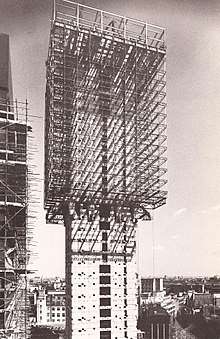GMW Architects
GMW Architects was an architectural practice based in the United Kingdom. In August 2015, the firm was taken over by another business, Scott Brownrigg, "as part of plans to move into the airport sector."[1]

History
The practice was established in 1947 by Frank Gollins (1910–1999), James Melvin (1912–2012) and Edmund Ward (1912–1998), and operated as Gollins Melvin Ward. In the 1950s it designed Castrol House, a tower on Marylebone Road in London, notable as one of the first uses of curtain walling on a building in the United Kingdom, and the central campus for the University of Sheffield.[2]
In the 1960s it went on to design two buildings at Undershaft in the City of London: the 28-storey Commercial Union Tower, the first building in the city to exceed the height of St Paul's Cathedral, and the now demolished headquarters of P&O. These buildings both featured an innovative structure by which the office floors are hung by steel rods from cantilevers extending out from the concrete core, rather than being supported from ground level.[3]

The three founders retired in 1974, leaving a well-established practice. Soon afterward, GMW was awarded a commission to design the King Saud University in Saudi Arabia.[2]
In 1983, the firm was appointed to design the new Barclays Bank headquarters building at 54 Lombard Street; eleven years later, the practice was appointed to handle the refurbishment of Tower 42 in London.[2]
BIM
The company played a role in the early development of building information modelling, employing the developers of RUCAPS, the first 'building modelling' application (used for the King Saud University project), and from 1977 sold through GMW Computers Ltd in several countries worldwide.[4] It was amongst the leading systems of its time, selling many hundreds of copies at a time when computer-aided design was rare and expensive. The term 'building model' (in the sense of BIM as used today) was first used in a 1986 paper by Robert Aish[5] – then at GMW Computers – referring to the software's use at London Heathrow Airport's Terminal 3,[6] and it is regarded as a forerunner to today's BIM software.[7][8]
Current activities
By the time of its 2015 acquisition by Scott Brownrigg, GMW had become a transport specialist. It undertook work for Network Rail, had recently completed the passenger terminal at the Prince Mohammad bin Abdulaziz Airport in Medina, and continued to work on the completion of the Istanbul New Airport (designed by Grimshaw Architects, Nordic Office of Architecture and Haptic).[1] Following the acquisition, the practice ceased working under its own name.[1]
References
- Mark, Laura. "Scott Brownrigg buys GMW Architects (11 August 2015)". Architects Journal. Retrieved 12 August 2015.
- GMW Partnership website
- "20th Century Society - Building of the Month December 2004". Archived from the original on 2011-08-13. Retrieved 2011-06-04.
- Port, Stanley (1989). The Management of CAD for Construction. New York: Springer. ISBN 9781468466058.
- Aish, Robert (1986) "Building Modelling: The Key to Integrated Construction CAD" CIB 5th International Symposium on the Use of Computers for Environmental Engineering related to Building, 7–9 July.
- cited by Laiserin, Jerry (2008), Foreword to Eastman, C., et al (2008), op cit, p.xii
- Eastlake, Chuck; Tiecholz, Paul; Sacks, Rafael; Liston, Kathleen (2008). BIM Handbook: a Guide to Building Information Modeling for owners, managers, designers, engineers, and contractors (1st ed.). Hoboken, New Jersey: John Wiley. pp. xi–xii. ISBN 9780470185285.
- Eastlake, Chuck; Tiecholz, Paul; Sacks, Rafael; Liston, Kathleen (2011). BIM Handbook: A Guide to Building Information Modeling for Owners, Managers, Designers, Engineers and Contractors (2nd ed.). Hoboken, New Jersey: John Wiley. pp. 36–37.